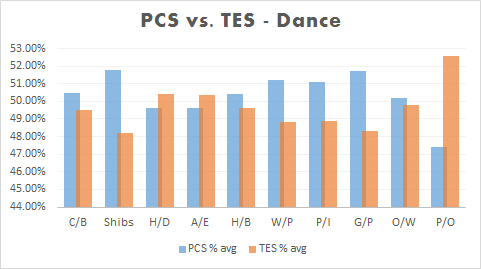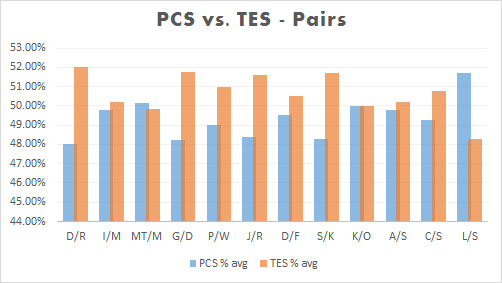While our previous entries have focused exclusively on the question of PCS, an overall evaluation of fall results has prompted a secondary question: what relationship, if any, exists between the role of PCS and that of the ostensibly more objective TES?
*Note: Deductions when present have been added back to total scores to allow for more accurate percentages, as TES and PCS reflect a score as directly assigned.
*Note: Hover over percentages on spreadsheet to see actual assigned PCS and TES scores.
Evaluating the season scores of the internationally-competitive teams reveals certain fairly obvious truths: for example, scores of especially poor technical skates, primarily those in which an element is invalidated, tend to be weighted more heavily towards PCS, and this tendency is not distributed evenly among teams. If a couple falls within a certain anticipated PCS range and is unlikely to fall out of it — and our previous entries have demonstrated the commonality of a standard PCS range (or expected trajectory) for any given team — then it will outweigh the unusually low technical mark in forming a total score. This phenomenon was demonstrated well at Autumn Classic International, with Piper Gilles & Paul Poirier losing a lift in their short dance and Alexandra Paul & Mitch Islam a spin in their free dance.
Total average PCS weight, Gilles & Poirier = 51.7% (high/low removed = 50.9%)
ACI short dance PCS weight = 58.3%
Total average PCS weight, Paul & Islam = 51.1% (high/low removed = 50.5%)
ACI free dance PCS weight = 54.6%
Among juniors, this almost negative relationship between technical achievement and component weight can also be seen in the marks for 2014 World Junior bronze medalists Madeline Edwards & ZhaoKai Pang, competing for the second year nationally as seniors. The team has received low levels in their Junior Grand Prix events, yet even while picking up lower actual scores and PCS than fellow Canadian Junior Grand Prix finalists — and national seniors — Mackenzie Bent & Garrett MacKeen, their PCS share has been consistently steep:
Total average PCS weight, Edwards & Pang = 53.7% (high/low removed = 54%)
Total average PCS weight, Bent & MacKeen = 50.9% (high/low removed = 50.7%)
Total average PCS weight among seniors = 50.5%
That status for Edwards & Pang — reigning world medalists at the junior level — may in fact suggest a microcosm of a possible pattern at the senior level. Essentially, there seems to exist a correlation between international establishment as a couple, assessed here with the very general measurement of trips to and medals received at Junior World and World Championships, and weight of PCS in total score.
Removing a high and low, with highest PCS weights especially skewed by a poor technical performance, actually reveals very little change, though this adjustment of course does not cover teams who may have had additional low TES outings:
51.9% = Maia Shibutani & Alex Shibutani (4 Worlds [1 bronze]; 2 Junior Worlds [1 silver])
51.3% = Kaitlyn Weaver & Andrew Poje (6 Worlds [1 silver]; 1 Junior Worlds [bronze])
50.9% = Piper Gilles & Paul Poirier (2 Worlds)
50.6% = Madison Chock & Evan Bates (2 Worlds)
50.5% = Alexandra Paul & Mitch Islam (1 Worlds; 1 Junior Worlds [silver])
50% = Nicole Orford & Thomas Williams (2 Junior Worlds)
49.9% = Kaitlin Hawayek & Jean-Luc Baker (2 Junior Worlds [1 gold])
49.7% = Madison Hubbell & Zach Donohue (1 Worlds)
49.5% = Alexandra Aldridge & Daniel Eaton (1 Worlds; 2 Junior Worlds [2 bronze])
47.4% = Élisabeth Paradis & François-Xavier Ouellette (0 Worlds)
Given their Junior Worlds success and trip to Worlds, Aldridge & Eaton serve as an outlier to this theory, though a general stagnation of results and the challenges associated with entering the senior circuit in an Olympic year — the team’s personal best short dance score was obtained on the 2012 Junior Grand Prix circuit; they were last season assigned to one Grand Prix, competed at a Four Continents absent of several top couples, and entered Worlds as second alternates and fifth-place Nationals finishers — may here serve to counteract their position as a tenured team.
An analysis of pairs, meanwhile, seems to tell a very different story. Certainly the most-established team on the list, Meagan Duhamel & Eric Radford, actually possess the lowest average PCS weight, of 48% (47.65% with high/low removed), while two of those teams ranking highest — Dee Dee Leng & Simon Shnapir and Kirsten Moore-Towers & Mike Marinaro — are in their first seasons together and have each competed at only two events. Though the recent international reputations of Shnapir (2 Worlds) and Moore-Towers (3 Worlds) may factor in, another explanation may be the stronger emphasis placed upon technical achievement in pairs than in dance, where elements are fewer, as well as the temperamental nature of that achievement given the greater risk of falls on jumps and aborted lifts. To that end, teams with more secure or higher-wattage elements may be rewarded most generously for that ability.
A look at the most successful junior pair in North America, Canada’s Julianne Séguin & Charlie Bilodeau, who like the young dancers will be competing among seniors at Nationals, provides an additional spin on the matter of technical weight. While average growth in PCS weight from the short program to the long program (0.7 points) is considerably greater than that between the short dance and the free dance (0.2-0.3), the SP’s legacy as the “technical program” is well demonstrated by this duo:
Total average PCS weight, Séguin & Bilodeau = 47.7% (high/low removed = 47.9%)
Average short program PCS weight = 44.7%
Average long program PCS weight = 50.6%
However, technical consideration may not cover obvious error as much as overall execution and element difficulty. An evaluation of PCS weight for skates that included one or more falls shows an average of 48.2%, very close to the overall senior average of 48.4% (also the average of all non-deduction skates) — suggesting that one type of error, at least, is rarely compensated by heightened component marks.
From highest to lowest, then, PCS averages for international senior pairs, with high/low marks once again removed:
51.45% = Dee Dee Leng & Simon Shnapir (new couple; Shnapir: 2 Worlds, 1 Junior Worlds [bronze])
50% = Tarah Kayne & Danny O’Shea (0 Worlds)
50% = Madeline Aaron & Max Settlage (1 Junior Worlds)
49.95% = Kirsten Moore-Towers & Mike Marinaro (new couple; Moore-Towers: 3 Worlds; Marinaro: 3 Junior Worlds [1 silver])
49.8% = Lubov Iliushechkina & Dylan Moscovitch (new couple; Moscovitch: 3 Worlds)
49.75% = Natasha Purich & Drew Wolfe (new couple; Purich: 1 Junior Worlds)
49.5% = Haven Denney & Brandon Frazier (2 Junior Worlds [1 gold])
49.15% = Jessica Calalang & Zack Sidhu (1 Junior Worlds)
48.4% = Brittany Jones & Josh Reagan (Jones: 3 Junior Worlds; Reagan: 1 Junior Worlds)
48.3% = Vanessa Grenier & Maxime Deschamps (0 Worlds)
48.25% = Alexa Scimeca & Chris Knierim (1 Worlds)
47.65% = Meagan Duhamel & Eric Radford (4 Worlds [2 bronze])


